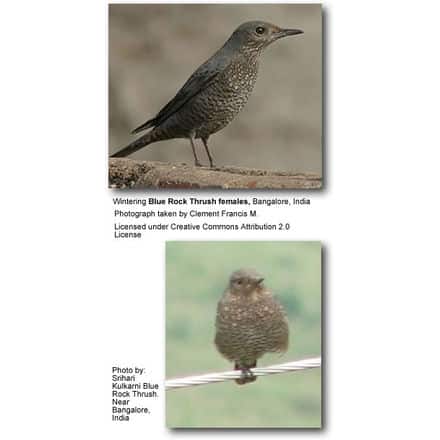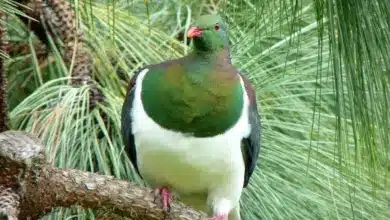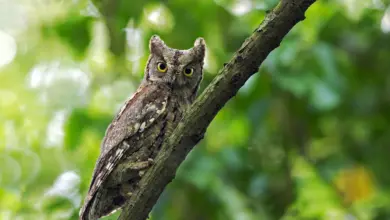Blue Rock Thrush or Blue Rock-Thrush
The Blue Rock Thrushes (Monticola solitarius) are members of the thrush family (Turdidae). Their wide range stretches from Europe south through the Mediterranean Sea to Africa and east to Asia.
In Malta, these birds were given special status as “National Birds” as part of an effort to protect these birds from extinction.
Their eggs were popular by collectors and as their nests were being robbed, their numbers declined, and these birds became rare. In addition to being Malta’s national bird, it is also featured on the Lm 1 coins of the country.
It is now illegal to hunt these birds or to disturb their nests.
Distribution / Habitat
This species breeds in southern Europe and North Africa, the Middle East and across Asia to northern China, Japan and Malaysia. Vagrants have been reported in northern and Western Europe.
Populations found in Europe, northern Africa and Southeast Asia are mostly sedentary (non-migratory), except for some altitudinal movements.
Others are migratory, traveling south to winter in sub-Saharan Africa, India and southeast Asia.
They inhabit rocky coastlines and cliffs and mountain valleys. Migrating birds can be found in groves, open meadows and forests.

Subspecies and Ranges:
- Western Blue Rock-Thrush (Monticola solitarius solitarius – Linnaeus, 1758) – Nominate Form
- Range: Spend the summers (breeding seasons) in southern Europe – east to Italy and northern Balkans, northwestern Africa, northern Turkey, Middle East and Transcaucasia. They migrate south for the winters to central Africa and Arabia
- Iranian Blue Rock-Thrush (Monticola solitarius longirostris – Blyth, 1847)
- Range: Greece, western and southern Turkey, Eastern Mediterranean, and south to Northern Iraq and Iran west to Pakistan; and west to Levant to the Tian Shan mountain ranges in Central Asia and northwestern Himalayas. They migrate south to winter in northern India and northeastern Africa.
- Blue Rock-Thrush (pandoo)(Monticola solitarius pandoo – Sykes, 1832)
- Range: Spend the summers (breeding seasons) in the central Himalayas, central and eastern China (including Hainan) and northern Vietnam. They winter in southern and southeastern Asia south to the Greater Sundaes.
- Blue Rock-Thrush (madoci)(Monticola solitarius madoci – Chasen, 1940)
- Range: Extreme southern Thailand, Malay Peninsula and northern Sumatra
- [Blue Rock-Thrush (magnus) (Monticola solitarius (magnus))] – not universally recognized
- Red-billed Rock-Thrush (Monticola solitarius philippensis – Statius Müller, 1776)
- Range: Southeastern Siberia south to eastern Mongolia, northeastern China, Korea, Southern Sakhalin, southern Kuril Islands, Japan, Ryukyu Islands and on Batanes Island in the northern Philippines. Winter in southeastern China and Philippines south to the Sunda Islands in the Malay Archipelago.
Description
Size
- Length: 7.9 – 9 inches (20 – 23 cm) – slightly smaller than a Blackbird
- Weight: 1.8 – 2.5 oz (50 – 70 grams)
Plumage Details / Adults
Male:
- Breeding Plumage: Upper plumage deep blue, with blackish wings and tail feathers with slate-blue edges on outer rectrices. Head is blue with blackish lores (area from the bill to the eyes). Plumage below is slightly paler.
- Winter Plumage: Upper plumage is duller, darkish-brown plumage with pale mottling. The wings and tail are darker, but with paler edging and tips. The feathers below have pale tips.
Female:
- Dark-brown slightly bluish tinged above. Below pale-brownish or dark-grey heavy mottled. The undertail is rusty-buff with black bars. The wings and the tail are dark-brownish.
Other Physical Details
- Long, slim, black bill.
- Dark brown eyes
- Legs and feet range in color from greyish-black to black
Juvenile Description
Immature birds have buffy-colored upper plumage. The plumage below is greyish-buff dark-brownish mottled.
Similar Species
- Rock Thrush: Can be identified by their reddish outer tail feathers.
Diet / Feeding
Feed on a wide variety of insects, lizards, fruits and berries.
Breeding / Nesting
Breeding mostly occurs between May and July.
The Blue Rock Thrushes nest in open mountainous areas on cliffs and rocky slopes. The females construct the nests with dry grass stems and thin grasses. The nests are lined with rootlets and other soft plant material found in their environment.
The average clutch consists 5 eggs, but as few as 3 or as many as 7 can be laid. Both parents feed and protect the young.
After the breeding season, the birds begin their migration to their wintering ranges in the second half of August to mid-September.




